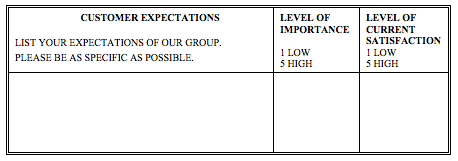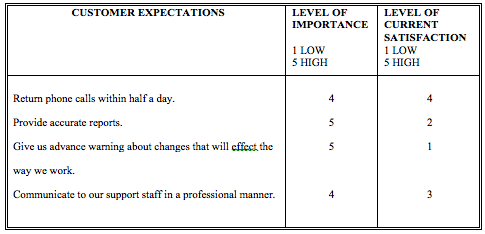“Our group is planning where to focus our improvement efforts for the next few years. We want input from our customers and employees, but don’t really know how to organize ourselves to get this input. What do you suggest?”
#6 Expectations Survey
What Is an Expectations Survey?
Expectations Survey is a technique designed to gather quantifiable information from customers of a specific group. In this case, a group can mean a company, division, department, or team within any organization. An Expectations Survey measures the expectations of a group from a wide variety of customers. This information then provides a basis for examining priorities and setting goals.
The term customer not only refers to the traditional concept of the customer, who is typically the end user or purchaser of an organization’s products or services. A customer can also be defined as anyone who is impacted by a group’s products or services. This includes the traditional customer noted above, as well as employees, management, stockholders, suppliers, lenders, and others.
Without input from its customers, no group will ever have a complete picture of its top priorities. Understanding the needs and priorities of customers has become commonplace because it makes good business sense. Any group or organization who neglects to do so will likely experience rework, loss of market share, and unnecessary conflict over priorities.
When Do I Use Expectations Survey?
- When preparing to agree group or team goals
- When you want to establish priorities for improvement
- When you want feedback from your customers
How Do I Use Expectations Survey?
1. Present the purpose of the Expectations Survey to your meeting group. For example: “Expectations Survey is a technique for gathering information and feedback from all the customers of a group, both inside and outside the organization. This information measures the perceived expectations of these customers and provides a basis for decision making and goal setting.” To support your efforts, you might ask the group, “What would you see as the advantages of our asking customers for their expectations?” …”What would be the disadvantages?” …”How could we use this information to help us plan our improvement efforts?”
2. Determine which customer groups to ask for feedback. Be sure to include all customers that are impacted by the activities of your specific meeting group.
3. Make logistical decisions. You might ask the group, for example, “Will the survey be executed in person or in writing?” “Who will conduct and coordinate gathering the responses?” “What are the time frames involved?” “Who will send the invitation to participate?”
4. Agree on how to prepare the information for analysis at your next meeting. Determine the specifics by asking, “Who will do what by when?”
5. Agree on an appropriate amount of time to follow up with your customers. This follow up will test your group’s progress towards the improvements identified by your customers.
6. Plan how to communicate to your customers about the Expectations Survey. Agree on any written communication to each customer group. Be sure to clearly communicate the purpose of the survey when communicating with your customers. For example: “We are currently planning how to better serve you in the future. Please help us plan appropriately by sharing your expectations of our group, how important each of these expectations is to you and how well we are currently meeting those expectations.”
7. Prepare Expectations Survey sheets. An example is below.
8. Conduct the Expectations Survey.
NOTE: Be sure to coach any interviewers to remain neutral and non-defensive. Issues will surface that might surprise the interviewers, and their reactions may impact the quality of responses. Remind them that all feedback is valuable feedback, even if it exposes a misunderstanding between the customer and the group. While on-the-spot problem solving on little problems is sometimes acceptable, the goal of the Expectations Survey meeting is information gathering, not problem solving.
9. Collect and tabulate all the information. Cluster information together as is appropriate and possible. It may be helpful to sort the information by different types of customer.
NOTE: Look for the biggest gaps, where the level of importance is very high and the level of current satisfaction is very low. These are the areas where you have the biggest opportunities for improvement and where your clients will take notice. The figure below provides an illustration.
As you can see from the example, giving advance warning about upcoming changes and providing accurate reports are the most important opportunities for improvement in this Expectations Survey.
10. Use this information in planning goals for the next period. This period could be six months, one year, two years, or whatever period is practical given the nature of the information collected.
11. Communicate to your customers involved in the Expectations Survey what you found and what your group intends to do with the information. Share the specific goals you have set in response to the information.
12. After the agreed-upon time frame, return to your customers for additional feedback. Ask them once again for their expectations of your group, their ranking of these expectations and their current level of satisfaction. Benchmark the progress of your efforts from one year to the next.
NOTE: This is a process that your group could continue or modify on an annual or otherwise regular basis.
In Summary:
Expectations Survey is a technique for gathering information and feedback from all the customers of a group, both inside and outside the organization. This information measures the expectations of these customers along with current levels of satisfaction, and provides a basis for decision making and goal setting.
1. Introduce the concept and purpose of an Expectations Survey.
2. Determine which customer groups to ask for feedback.
3. Make the necessary logistical decisions.
4. Agree how to specifically prepare the returned information for analysis at your next meeting with this group.
5. Agree on an appropriate amount of time to follow up with your customers.
6. Plan how to communicate to your customer groups about the Expectations Survey.
7. Prepare the Expectations Survey sheets.
8. Conduct the Expectations Survey.
9. Collect and analyze the information.
10. Use this information with your group in planning goals for the next period.
11. Communicate the results to the customer groups involved in the Expectations Survey.
12. After an agreed upon time frame, return to the customer groups for feedback on any improvements, changes, or additional concerns.
———————-
NOTE: If you would like to receive e-mail notification when I post additional techniques, please sign up through this link. http://eepurl.com/KILan You may unsubscribe at any time.

